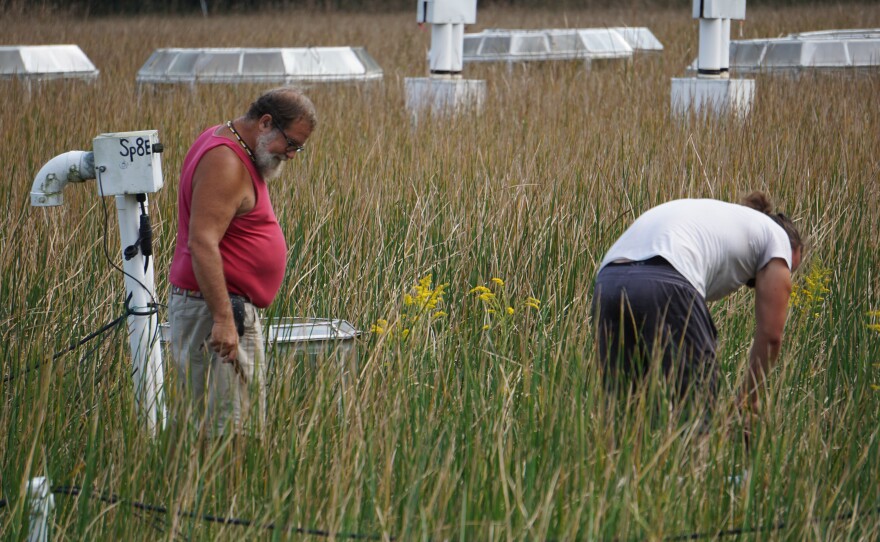
If you visit the tiny Virginia town of Saxis, just across Pocomoke Sound from Crisfield, Maryland, you’ll be greeted by fields of bobbing, feathery heads of 10-foot phragmites.
The tall reed launched its invasion of the Chesapeake Bay centuries ago when the plants hitched a ride across the Atlantic with the first European colonists. And for the most part, it’s been seen as a pesky plant that clogged wetlands and waterways, taking over the habitat of native plants.
M.K. Miles, who grew up in Saxis, stands next to one of the island’s many fields of phragmites. This one blocks the water view from a neighbor’s yard.
“So, they’re down here for a sea view and they got none,” he said. “She said, ‘M.K., what can we do?’ I said just cut it. She said, ‘You can’t just cut marsh grass.’ I said it’s not marsh grass. It’s phragmites.”
That blocked sea view may be annoying for homeowners, but new studies show a flip side to phragmites. They can store carbon dioxide and help stave off sea-level rise by way of those ever-growing roots.
“The data are telling us that phragmites actually helps the marsh gain elevation faster because of all the root productivity,” explained Patrick Megonigal, senior scientist at the Global Change Research Wetland, part of the Smithsonian Environmental Research Center’s operations south of Annapolis.
“In that way it might help a marsh faced with very high rates of sea-level rise build upward and remain a marsh instead of becoming open water,” he said.
Scientists at the research wetland are conducting a number of experiments to determine how global warming will affect Bay wetlands, and one of them looks at how excess carbon dioxide, the gas most connected to climate change, affects phragmites.
But for biologists like Matt Whitbeck at the Blackwater National Wildlife Refuge, phragmites are a double-edged sword.
“As far as just hanging on to wetland environments, phragmites may not be that bad, but from a habitat standpoint it's horrible,” he says. “So, if you're a seaside sparrow, if you're a salt marsh sparrow, if you're a black rail there's no habitat in a phragmites monoculture for you, and that's the issue.”
But according to Gary Peresta, an environmental engineer at the Smithsonian’s research wetland, there are native phragmites as well as the invaders.
“We know from genetics, there's local phragmites that doesn't grow as big,” he says. “Same species. It's not even a different species, it's just a different genetics train.”
He and Megonigal are housing the phragmites they’re experimenting with in tall PVC pipe frames wrapped in plastic and feeding them pure carbon dioxide.
Peresta says phragmites are better at building marshes than native species, making it a potential hero as rising seas drown native grasses. That spurs a "marsh moment" as the two discuss their role in a changing climate.
“I think there is a question that the science and management community need to wrestle with, which is how much effort do you spend trying to remove (phragmites),” Megonigal says.
“And this is always a complicated conversation about what the goals are for managing any kind of natural ecosystem like a marsh. Are you trying to manage it for bird habitat, to survive accelerated sea level or for removing nitrogen from the bay. The decisions you make about phragmites, for example, often depend on those goals.
Peresta says it’s hard for scientists.
“We have to be careful as we talk about this stuff because you can't just generalize and say, “it's all bad,” because it may be better for some species and worse for others,” he says. “It's just going to change things. That much we can say. Arguably, now, we're called upon more to be more vocal about what's going on because it is a complicated picture and we need to be honest about the complications but the overall picture is not really in question.”









